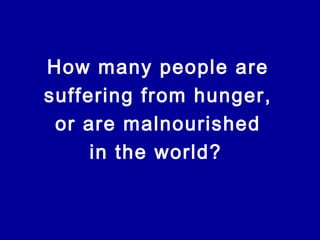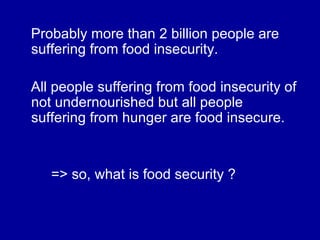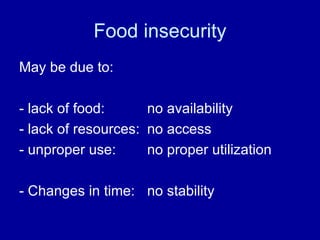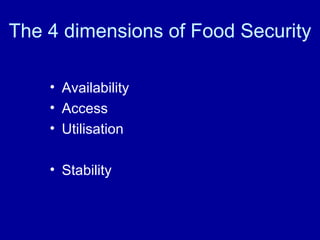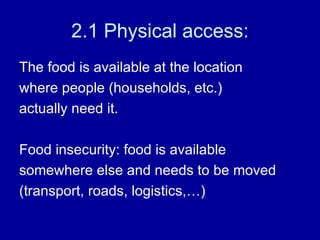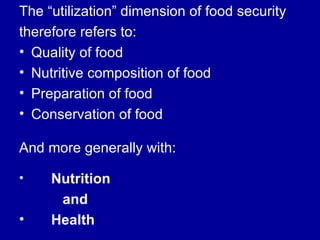NutritionCamp. Food Security - Prof. George Simon
- 1. Food Security Rome, 14th November 2009 Barilla Nutritioncamp
- 2. How many people are suffering from hunger, or are malnourished in the world?
- 3. 842 million in 1990/92 832 million in 1995/97 848 million in 2003/2005 860 million in 2004/2006 Estimation/projections 923 million = estimation for 2007 963 million = estimation for 2008 1.02 billion = estimation for 2009
- 4. Is this due to population growth ? No. From 1960 to 2000 agricultural production increased more than population. Food availability increased. Now about 2.800 calories per person available world wide. About 9 billion people may be fed with the present agricultural production. => What are the basis for calculation
- 5. Undernourishment exists when caloric intake is below the minimum dietary energy requirement, which is the amount of energy needed for light activity and a minimum acceptable weight for attained height. Only energy and calories (macronutrients) varies by country and year Depends and gender and age structure of population Hence complex to calculate
- 6. Probably more than 2 billion people are suffering from food insecurity. All people suffering from food insecurity of not undernourished but all people suffering from hunger are food insecure. => so, what is food security ?
- 7. Definition Food Security Food security exists when all people, at all times, have physical, social and economic access to sufficient, safe and nutritious food which meets their dietary needs and food preferences for an active and healthy life. WFS, 1996
- 8. Definition Food insecurity It is a situation where some people do not have access to sufficient quantities of safe and nutritious food and hence do not consume the food that they need to grow normally and conduct an active and healthy life.
- 9. Food insecurity May be due to: - lack of food: no availability - lack of resources: no access - unproper use: no proper utilization - Changes in time: no stability
- 10. The 4 dimensions of Food Security Availability Access Utilisation Stability
- 11. 1. Availability Food security exists when all people, at all times, have physical, social and economic access to sufficient , safe and nutritious food which meets their dietary needs and food preferences for an active and healthy life.
- 12. Availability is defined as the amount of food that is physically present in a country or area through all forms of domestic production, commercial imports, including informal cross-border trade and food aid.
- 13. 2. ACCESS Food security exists when all people, at all times, have physical, social and economic access to sufficient, safe and nutritious food which meets their dietary needs and food preferences for an active and healthy life.
- 14. The fact that food be available in a country, a region of even a village is not enough to ensure that all people can actually eat it. There are three different “Access” to food: - physical - financial - socio-cultural
- 15. 2.1 Physical access: The food is available at the location where people (households, etc.) actually need it. Food insecurity: food is available somewhere else and needs to be moved (transport, roads, logistics,…)
- 16. 2.2 Economic access: The food is available where people need it and households have the ability to regularly acquire adequate amounts of food to meet their requirements. Food insecurity: food is available where people need it but they do not have the resources to buy it. This is why hunger and poverty are so closely related
- 17. 2.3 Socio-cultural access Food security: The food is available where People need it, households have the ability to regularly acquire food and there are no socio-cultural barriers to their consumption of the commodities. Food insecurity: food is available where people need and can buy it but there are socio-cultural barriers to consumption by all.
- 18. 3. UTILISATION Food security exists when all people, at all times, have physical, social and economic access to sufficient, safe and nutritious food which meets their dietary needs and food preferences for an active and healthy life.
- 19. The “utilization” dimension of food security therefore refers to: Quality of food Nutritive composition of food Preparation of food Conservation of food And more generally with: Nutrition and Health
- 20. 4. STABILITY Food security exists when all people, at all times , have physical, social and economic access to sufficient, safe and nutritious food which meets their dietary needs and food preferences for an active and healthy life.
- 21. The Four Dimensions of Food Security: A Conceptual Framework Domestic production Food imports Food stocks Food aid Transport and market facilities Poverty Purchasing power Socio-cultural organization Food distribution Care and feeding Food safety & quality Quality of water Nutrition Health/sanitation education Weather variability Political and economical factors (Man made emergencies) Price fluctuations Availability Access Utilization Stability
- 22. Conclusion: Hunger, malnourishment and food insecurity are complex concepts. Hunger and poverty are very closely related. Fighting hunger and poverty requires multidimensional analysis and actions that can not be limited to increasing production, controlling prices or improving quality of food.


